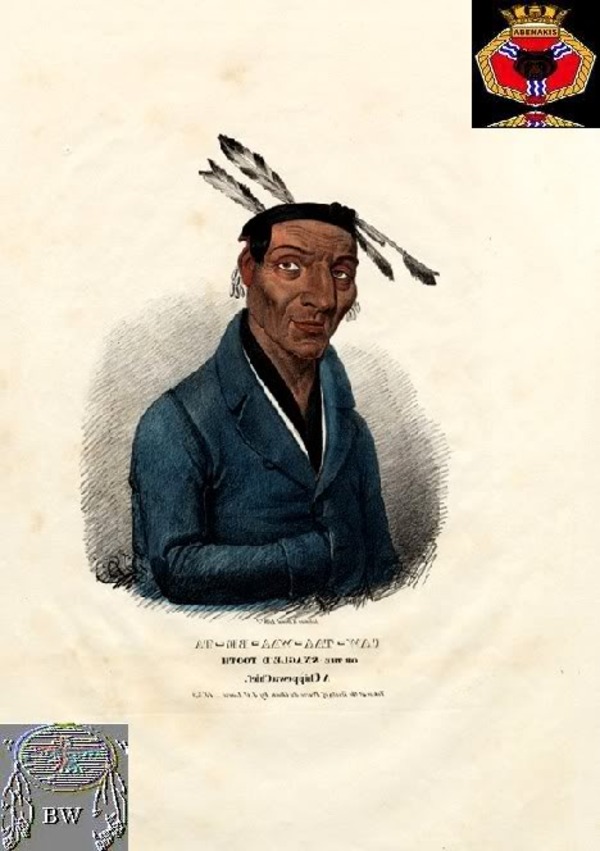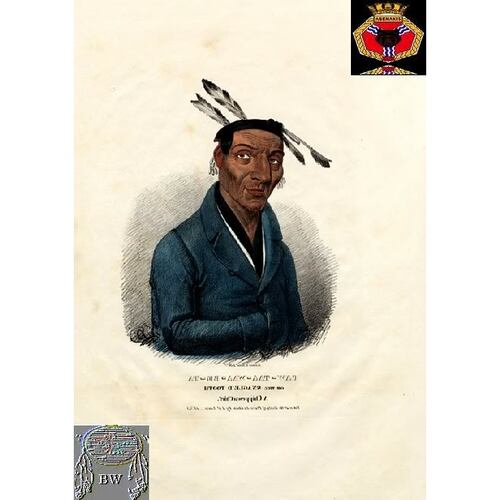
Source: Link
SAUGUAARAM (Laron, Loring, Loron, Sagouarrab, Sagouarrat, Saguaarum, Seguaron), Penobscot Abenaki sachem, warrior, orator; fl. 1724–51 in the vicinity of the Penobscot River, Massachusetts (now Maine).
Sauguaaram first appears in historical records during Dummer’s War (1722–27) between the Abenakis and Massachusetts. After the deaths of Mog* and Father Sébastien Rale* at Norridgewock (Narantsouak; now Old Point, Madison, Me.) in 1724 and the second destruction of their own village early in 1725, the Penobscots considered the war lost and accepted Massachusetts’ invitation to negotiate a treaty. Although Wenemouet* was Sauguaaram’s superior in rank, it was Sauguaaram who spoke for the tribe at the conferences in July and August 1725, November and December 1725, and again in July and August 1726.
The Penobscots’ moves for peace were a radical break with the policy of the French and the Canadian Abenakis. To maintain the traditional alliance, Sauguaaram travelled to Canada between conferences, trying unsuccessfully to persuade them to agree to a peace. In the negotiations with the English, Sauguaaram achieved an implicit acceptance by Massachusetts of the presence of Jesuit missionaries among his tribe and by helping improve trade relations between the Penobscots and the English he laid the cornerstone for the subsequent peace. Despite his pleading, however, Massachusetts refused to admit that her settlements had caused the war, nor would she agree to limit them. She also insisted that the ratifying tribes aid her in suppressing future Indian uprisings, and this article became a strong irritant throughout the remaining colonial wars. War weariness, not generous concessions, led Sauguaaram and the Penobscots to accept a tentative agreement.
Sauguaaram repudiated the agreement in January 1726 [n.s.], after Étienne Lauverjat, the missionary at Pannawambskek (Panaouamské; Indian Island, Old Town, Me.), interpreted the document to him. He had not intended, the sachem said, to acknowledge the British king or to agree to force the other tribes to submit. Whether there had been a genuine misunderstanding, or whether Sauguaaram’s move was a tactic of negotiation, Massachusetts was unwilling to make further concessions. So Sauguaaram acquiesced, and the Penobscots accepted the treaty on 5 Aug. 1726.
Sauguaaram learned a valuable lesson from the treaty negotiations: Massachusetts would not compromise her claims, and the French were hostile to conferences in any case. His solution was to maintain good relations with both colonies. Pleased by his cooperation, Lieutenant Governor William Dummer of Massachusetts called him a “particular Friend” and sent him a gun marked with his totem. Sauguaaram was unusually favoured by the truck master at Fort St George (now Thomaston, Me.) in return for information.
When the treaty that Massachusetts had negotiated with the Penobscots was ratified by all the Abenaki tribes in July 1727, Sauguaaram signed it. He wrote to Governor Charles de Beauharnois, however, reaffirming his original interpretation of the document. “If, then, anyone should produce any writing that makes me speak otherwise, pay no attention to it,” he explained, “for I know not what I am made to say in another language. . . .”
Although eager to keep on good terms with both colonies, Sauguaaram remembered the Penobscots’ interests. When Father René-Charles de Breslay* was mistreated in Nova Scotia, Sauguaaram angrily reminded the Massachusetts governor that “as to our Religion, Wee were not to Interrup’t one the other in the Injoyment of itt.” On the same grounds he refused an offer of Protestant missionaries in 1732, and led his tribe’s opposition to English settlements in the Penobscot River region. The dispute over the settlements drove the Penobscots into closer ties with the French, and several sachems surrendered their English commissions to Governor Beauharnois. Sauguaaram himself had never accepted one of these tokens of English favour, and he complained in fact to the Massachusetts governor that they made the Indians “exceeding proud, & they breed mutinies & wont come to Prayers, but do nothing but get drunk.”
The Penobscots were still determined to preserve good relations with both English and French, and in accordance with the treaty Sauguaaram spent the summer of 1740 calming the Abenakis of Saint-François, who were angered by Massachusetts’ expansion. On his return he exasperated Governor Jonathan Belcher by cautioning Massachusetts to avoid irritating the other Abenaki tribes. “It looks as if you were ready,” Belcher told him, “to take up the Hatchet and were directed in it by the French. . . .” “We are a free People,” Sauguaaram replied.
Sauguaaram always led the attempt to achieve better trading conditions. He complained to the Massachusetts governor about prices and about the acting truck master at Fort St George. He also frequently asked that the rum trade be more closely regulated because “it interrupts our Prayers & does us Mischeif. . . .”
By the fall of 1744 the Indians of Nova Scotia and the Saint John River had begun open warfare against the English. Governor William Shirley of Massachusetts had hoped to prevent the Abenakis from joining the French, but some of the Penobscots, provoked in part by his demand that they join in suppressing the outbreak, attacked Fort St George in June 1745. Sauguaaram attempted to soothe the English in October, when he and three other Indians brought word that “the Jesuits have told them [the Indians] not to hurt ye English any more. . . .” That night Sauguaaram and his companions were attacked by a scouting party, and only Sauguaaram escaped. He and the remaining Penobscots fled to Canada, where he told Beauharnois that 25 warriors had set out to take revenge on Massachusetts. The Penobscots remained in Canada, sending forays into New England, for the rest of the war. One of Sauguaaram’s sons was killed in the conflict, and the sachem was reluctant to make peace. Although he foresaw that “when there is a French war we must break again,” the Penobscots finally ended their part in King George’s War with a treaty signed at Falmouth (Portland, Me.) in October 1749.
The treaty failed almost immediately when a Norridgewock Indian was killed at Wiscasset, Massachusetts (now Maine), in December 1749. You promised us justice, Sauguaaram reminded the lieutenant governor, “so we expect you will realy do it.” By June 1750, however, one of the accused Englishmen had been acquitted and the trial of the other two had been postponed. Although the French encouraged the Abenakis to take revenge, Sauguaaram and the Penobscots assured Massachusetts that they desired peace. The final reference to Sauguaaram in Massachusetts documents reveals that in September 1751 he was still working for peace, but all his efforts and those of the Norridgewock sachem Nodogawerrimet failed to prevent continued English intrusion into Indian lands.
Sauguaaram’s life reflects all the major issues between the Abenakis and Massachusetts. Under his leadership the Penobscots protected their religion, agitated for better trading conditions, opposed new settlements, and balanced their affairs between the demands of New France and New England.
Mass., Archives, Council records, VIII, IX, XI, XII. Benjamin Coleman, “Some memoirs for the continuation of the history of the troubles of the New-English colonies . . . ,” Mass. Hist. Soc. Coll., 1st ser., VI (1799), 108–18. Coll. de manuscrits relatifs à la N.-F., III, 128, 134–36, 140–41, 149–50, 153, 188–90, 263–65. Correspondence of William Shirley (Lincoln), I, 253–54, 261. Documentary history of Maine, X, XII, XXIII, XXIV. “Indian treaties,” Maine Hist. Soc. Coll., 1st ser., III (1853), 377–405, 407–47; IV, 145–67. New Hampshire, Provincial and state papers, published by the authority of the legislature of New Hampshire, ed. I. W. Hammond et al. (40v., Manchester, Concord, N.H., 1867–1943), IV. NYCD (O’Callaghan and Fernow). PRO, CSP, Col., 1726–27, 137, 144, 335, 539, 574; 1727–28, 573–74; 1730, 101, 348, 369; 1731, 120. R. H. Lord et al., History of the archdiocese of Boston in the various stages of its development, 1604 to 1943 . . . (3v., New York, 1944), II. H. O. Thayer, “The Indian’s administration of justice: the sequel to the Wiscasset tragedy,” and “A page of Indian history: the Wiscasset tragedy,” Maine Hist. Soc. Coll., 2nd ser., X (1899), 185–211, 81–103.
Cite This Article
Kenneth M. Morrison, “SAUGUAARAM (Laron, Loring, Loron, Sagouarrab, Sagouarrat, Saguaarum, Seguaron),” in Dictionary of Canadian Biography, vol. 3, University of Toronto/Université Laval, 2003–, accessed March 29, 2025, https://www.biographi.ca/en/bio/sauguaaram_3E.html.
The citation above shows the format for footnotes and endnotes according to the Chicago manual of style (16th edition). Information to be used in other citation formats:
| Permalink: | https://www.biographi.ca/en/bio/sauguaaram_3E.html |
| Author of Article: | Kenneth M. Morrison |
| Title of Article: | SAUGUAARAM (Laron, Loring, Loron, Sagouarrab, Sagouarrat, Saguaarum, Seguaron) |
| Publication Name: | Dictionary of Canadian Biography, vol. 3 |
| Publisher: | University of Toronto/Université Laval |
| Year of revision: | 1974 |
| Access Date: | March 29, 2025 |



